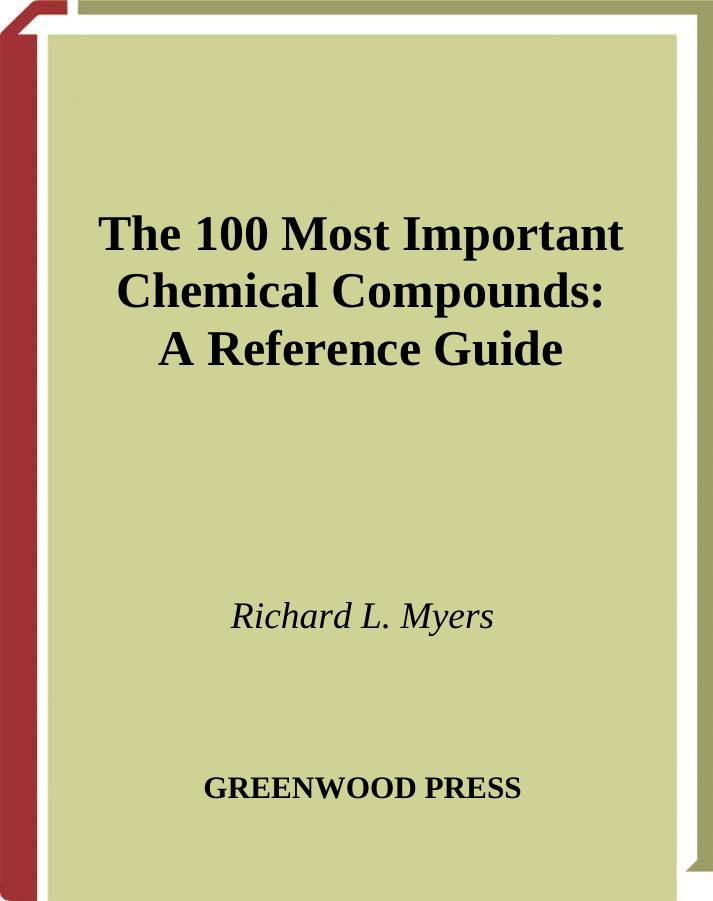The 100 Most Important Chemical Compounds: A Reference Guide by Richard L. Myers

Author:Richard L. Myers
Language: eng
Format: mobi, pdf
Tags: Chemistry, Reference, Science & Mathematics
ISBN: 9780313337581
Publisher: Greenwood
Published: 2007-01-02T00:00:00+00:00
52. Iron(III) Oxide
CHEMICAL NAME = iron(III) oxide
CAS NUMBER = 1317–60–8
MOLECULAR FORMULA = Fe O
2
3
MOLAR MASS = 159.7 g/mol
COMPOSITION = Fe(69.9%) O(30.1%)
MELTING POINT = 1,565°C
BOILING POINT = not reported
DENSITY = 5.24 g/cm3
Iron(III) oxide is known in mineral form as hematite, which is the primary form of iron ore.
It is also known simply as iron oxide or ferric oxide and is what is colloquially called rust when referring to the corrosion of iron objects. Th
e use of iron marked a signifi cant advance-
ment in human history and was the last of the three prehistoric archaeological stages after the Stone and Bronze Ages. Th
e period of the Iron Age is not fi xed but varied as technology
developed in diff erent geographic areas. In Egypt and the Near East there is evidence that smelted iron items appeared shortly after 2000 b.c.e., although crude iron objects appeared several hundred years before, and items made from iron obtained from meteorites were present even earlier. In central Europe the early Iron Age did not occur until roughly 800 b.c.e., and in the Americas smelted iron was not used until introduced by the European explorers and colonists.
Th
e smelting process involves reducing the iron, which is in an oxidized state in iron ore, to elemental iron. To obtain elemental iron, the iron-bearing mineral is heated with carbon so that the oxygen separates from the iron and bonds to the carbon. Smelting involves producing carbon monoxide by burning charcoal or coke to produce carbon monoxide, which is the reducing agent. Th
e carbon monoxide then reacts with iron oxide compounds to form
elemental iron. Th
e production of iron from iron(III) oxide can be summarized as:
2C + O → 2CO
(s)
2(g)
(g)
3CO + Fe O → 2Fe + 3CO
(g)
2
3(s)
(l)
2(g)
Iron(III) Oxide | 161
Carbon may also act directly as a reducing agent according to the equation: Fe O + 3C →
2
3(l)
(s)
2Fe + 3CO . Impurities such as silica, calcium, and aluminum are removed by adding lime-
(l)
(g)
stone or other agents in the process. Th
e impurities fl oat to the top of the molten iron as slag.
Th
e crude iron produced from smelting results in pig iron. Pig iron has a carbon content of 3–5%, a high percentage of impurities, and is very brittle. It is roughly 90% iron. Th e name
pig iron comes from the parallel sand bed molds fed by a common runner from the furnace.
Th
e parallel sand molds were thought to resemble suckling pigs. Pig iron must be further processed to reduce its carbon content and impurities to make useable iron and steel. Cast iron resembles pig iron, with a carbon content between 2% and 4%. Cast iron is hard and brittle.
Steel has intermediate carbon content between 0.2% and 2%. Steel is alloyed with an array of other metals to produce many types of steels. For example, stainless steel contains chromium and nickel. High carbon steel has a carbon content of about 1.5%, is very hard, and is used for cutting tools. Wrought iron is almost pure iron, with a carbon content less than 0.2%. It is soft and malleable but has little structural strength.
Download
The 100 Most Important Chemical Compounds: A Reference Guide by Richard L. Myers.pdf
This site does not store any files on its server. We only index and link to content provided by other sites. Please contact the content providers to delete copyright contents if any and email us, we'll remove relevant links or contents immediately.
A Dictionary of Sociology by Unknown(3025)
The Art of Dramatic Writing: Its Basis in the Creative Interpretation of Human Motives by Egri Lajos(3015)
The Dictionary of Body Language by Joe Navarro(2946)
0041152001443424520 .pdf by Unknown(2784)
How The Mind Works by Steven Pinker(2729)
Day by Elie Wiesel(2717)
Merriam-Webster's Collegiate Thesaurus, Second Edition by Merriam-Webster Inc(2710)
The Meaning of the Library by unknow(2503)
The Official Guide to the TOEFL Test by ETS(2285)
A History of Warfare by John Keegan(2184)
The Emotion Thesaurus: A Writer's Guide to Character Expression by Puglisi Becca & Ackerman Angela(2122)
Emotion Amplifiers by Angela Ackerman & Becca Puglisi(2007)
MASTER LISTS FOR WRITERS: Thesauruses, Plots, Character Traits, Names, and More by Bryn Donovan(1907)
The Cambridge Guide to English Usage by PAM PETERS(1880)
Merriam-Webster's Pocket Dictionary by Merriam-Webster(1880)
Star Wars The Rise of Skywalker The Visual Dictionary by Pablo Hidalgo(1843)
Lucky Jim by Kingsley Amis(1697)
American Accent Training by Ann Cook(1635)
Word by Word by Kory Stamper(1613)
